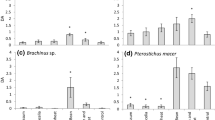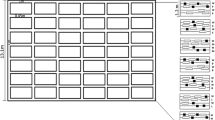Abstract
Crop cover nets are used in vegetables to reduce damage by pests. Recently, nets with 0.8 mm mesh size were recommended to protect Brassica vegetables from whiteflies, but farmers doubted their efficacy. We compared the impact of different mesh sizes on the abundance of insect pests and their antagonists on Brussels sprout in a field study and considered also important resource habitats, i.e. oilseed rape, in the surroundings. Cabbage whitefly was the most abundant pest followed by peach-potato aphid, cabbage aphid and diamondback moth. Aphid parasitism reached 48 % while syrphid larvae and spiders were the most abundant predatory taxa. The cabbage whitefly was less abundant under 0.8 mm nets in June and August compared to 7 mm nets, while no effect was observed in October. In general cabbage aphid, diamondback moth, syrphids and aphid parasitism were not affected by nets, but peach-potato aphid density increased under 7 mm nets late in the season. In contrast, spiders were less abundant under 0.8 mm than under 7 mm nets. Moreover, only the cabbage whitefly was positively affected by oilseed rape growing. In summary, 0.8 mm nets may be beneficial to reduce colonisation by cabbage whiteflies, especially in early summer and in landscapes with high colonisation pressure. Nets with wider mesh size may be appropriate in landscapes with low colonisation pressure by cabbage whiteflies since 0.8 mm mesh size had the disadvantages to support the peach-potato aphid and hinder colonisation by spiders.


Similar content being viewed by others
References
Bährmann R (2002) Die Mottenschildläuse: Aleyrodina (1st ed). Pflanzensaftsaugende Insekten (vol 2). Westarp Wissenschaften, Hohenwarsleben
Barton K (2016) MuMIn: multi-model inference. R package version 1.15.6. http://CRAN.Rproject.org/package=MuMIn
den Belder E, Landure J, Elderson J, Vlaswinkel M, Willemse J, van Alebeek FAN, van Rijn PA, van Gurp H (2008) Green bridges over the winter: consequences for Brassica pests. IOBC WPRS Bull 34:29–32
Burnham KP, Anderson DR (2002) Model selection and multimodel inference: a practical information-theoretic approach (2 edn, 2 print). Springer, New York
Byrne DN, Rathman RJ, Orum TV, Palumbo JC (1996) Localized migration and dispersal by the sweet potato whitefly, Bemisia tabaci. Oecologia 105(3):320–328. doi:10.1007/BF00328734
Capinera JL (2001) Handbook of vegetable pests. Academic Press, San Diego
Collier RH, Finch S (2007) IPM case studies: Brassicas. In: van Emden HF, Harrington R (eds) Aphids as crop pests. CABI, Wallingford, pp 549–559
Compton SG (2002) Sailing with the wind: dispersal by small flying insects. In: Bullock JM, Kenward RE, Hails RS (eds) Dispersal ecology. The 42nd symposium of the British Ecological Society held at the University of Reading, 2–5 April 2001 (1st edn). Blackwell Pub, Malden, pp 113–133
Dempster JP (1967) The control of Pieris rapae with DDT. I. the natural mortality of the young stages of Pieris. J Appl Ecol 4(2):485. doi:10.2307/2401350
Desneux N, Fauvergue X, Dechaume-Moncharmont F-X, Kerhoas L, Ballanger Y, Kaiser L (2005) Diaeretiella rapae limits Myzus persicae populations after applications of deltamethrin in oilseed rape. J Econ Entomol 98(1):9–17
Ester A, van der Zande JC, Frost A (1994) Crop covering to prevent pest damage to field vegetables and the feasibility of pesticide application through polyethylene nets. In: Proceedings of the Brighton crop protection conference, pests and diseases. British Crop Protection Council, Farnham, UK, issue 2, pp 761–766
Evans GA (2007) The whiteflies (Hemiptera: Aleyrodidae) of the world: and their host plants and natural enemies. http://keys.lucidcentral.org/keys/v3/whitefly/PDF_PwP%20ETC/world-whitefly-catalog-Evans.pdf. Accessed Aug 2016
Furlong MJ, Wright DJ, Dosdall LM (2013) Diamondback moth ecology and management: problems, progress, and prospects. Annu Rev Entomol 58(1):517–541. doi:10.1146/annurev-ento-120811-153605
Geiger F, Wäckers FL, Bianchi, Felix JJA (2009) Hibernation of predatory arthropods in semi-natural habitats. Biocontrol 54(4):529–535. doi:10.1007/s10526-008-9206-5
Hafez M (1961) Seasonal fluctuations of population density of the cabbage aphid, Brevicoryne brassicae (L.), in the Netherlands, and the role of its parasite, Aphidius (Diaeretiella) rapae (Curtis). Tijdschrift Over Plantenziekten 67(5):345–548. doi:10.1007/BF02089167
Hommes M (1993) Einsatz von Kulturschutznetzen im Gartenbau. Mitteilungen aus der Biologischen Bundesanstalt für Land- und Forstwirtschaft 289:104–110
Hondelmann P, Poehling H-M (2007) Diapause and overwintering of the hoverfly Episyrphus balteatus. Entomol Exp Appl 124(2):189–200. doi:10.1111/j.1570-7458.2007.00568.x
Jacobs W, Renner M, Honomichl K (1998) Biologie und Ökologie der Insekten: Ein Taschenlexikon (3. Aufl). G. Fischer, Stuttgart
Kirk WDJ (1992) Insects on cabbages and oilseed rape. Naturalists’ handbooks, vol 18. Richmond, Slough
Lefcheck JS (2015) piecewiseSEM: Piecewise structural equation modeling in R for ecology, evolution, and systematics. Methods Ecol Evol. doi:10.1111/2041-210X.12512
Lessing R (2013) Wirksamkeit von Insektenschutznetzen unterschiedlicher Maschenweiten bezüglich der Kohlmottenschildlaus (BSc-Thesis). Leibniz Universität Hannover, Hannover
Ludwig M, Schlinkert H, Meyhöfer R (2014) Impact of oilseed rape on initial colonisation and pre-harvest infestation of Brussels sprouts by cabbage aphid, cabbage whitefly and whitefly parasitoids. IOBC WPRS Bull 107:163–169
Monzó C, Mollá Ó, Castañera P, Urbaneja A (2009) Activity-density of Pardosa cribata in Spanish citrus orchards and its predatory capacity on Ceratitis capitata and Myzus persicae. Biocontrol 54(3):393–402. doi:10.1007/s10526-008-9199-0
Nakagawa S, Schielzeth H (2013) A general and simple method for obtaining R 2 from generalized linear mixed-effects models. Methods Ecol Evol 4(2):133–142. doi:10.1111/j.2041-210x.2012.00261.x
Nebreda M, Nombela G, Muñiz M (2005) Comparative Host Suitability of Some Brassica Cultivars for the Whitefly, Aleyrodes proletella (Homoptera: Aleyrodidae). Environ Entomol 34(1):205–209. doi:10.1603/0046-225X-34.1.205
Neuville S, Le Ralec A, Outreman Y, Jaloux B (2016) The delay in arrival of the parasitoid Diaeretiella rapae influences the efficiency of cabbage aphid biological control. Biocontrol 61(2):115–126. doi:10.1007/s10526-015-9702-3
Pasek JE (1988) 30. Influence of wind and windbreaks on local dispersal of insects. Agric Ecosyst Environ 22–23:539–554. doi:10.1016/0167-8809(88)90044-8
Pike KS, Starý P, Miller T, Allison D, Graf G, Boydston L, Miller R, Gillespie R (1999) Host Range and Habitats of the Aphid Parasitoid Diaeretiella rapae (Hymenoptera: Aphidiidae) in Washington State. Environ Entomol 28(1):61–71. doi:10.1093/ee/28.1.61
R Core Team. (2016). R: A Language and Environment for Statistical Computing. Vienna, Austria: R Foundation for Statistical Computing. Retrieved from http://www.R-project.org/
Richter E, Hirthe G (2014) Hibernation and migration of Aleyrodes proletella in Germany. IOBC WPRS Bull 107:143–149
van Rijn PA, den Belder E, Elderson J, Vlaswinkel MET, van Alebeek FAN (2008) Perspectives for functional agro biodiversity in Brussels sprouts. IOBC WPRS Bull 34:121–124
Saucke H, Giessmann M (2003) Eignung verschiedener Kulturschutz-Netze und Vliese zur Regulierung der Kohlmottenschildlaus (Aleyrodes proletella) in Rosenkohl. In: Rau F, Buck H (eds) Versuche im niedersächsischen Öko-Gemüsebau—2002. Kompetenzzentrum Ökolandbau Niedersachsen GmbH, Visselhövede, pp 115–118
Saucke H, Schultz B, Predatova M (2004) Eignung verschiedener Kulturschutz-Netze und Vliese zur Regulierung der Kohlmottenschildlaus (Aleyrodes proletella) in Rosenkohl. In: Rau F, Buck H (eds) Versuche im ökologischen Gemüsebau in Niedersachsen—2003. Kompetenzzentrum Ökolandbau Niedersachsen GmbH, Visselhövede, pp 145–149
Saucke H, Schultz B, Wedemeyer R, Liebig N, Zimmermann O, Katz P (2011) Biotechnische Regulierung der Kohlmottenschildlaus in Kohlgemüse—Sachstand und Perspektiven. Gesunde Pflanzen 63(4):183–189. doi:10.1007/s10343-011-0264-8
Schier A (1988) Untersuchungen zur Populationsdynamik der Getreideblattläuse unter besonderer Berücksichtigung ihrer natürlichen Gegenspieler (PhD Thesis). University of Hohenheim, Hohenheim
Schmidt MH, Lauer A, Purtauf T, Thies C, Schaefer M, Tscharntke T (2003) Relative importance of predators and parasitoids for cereal aphid control. Proc Biol Sci R Soc 270(1527):1905–1909. doi:10.1098/rspb.2003.2469
Stein E (1958) Untersuchungen über Biologie, Massenwechsel und Bekämpfung der Kohlmottenschildlaus, Aleurodes proletella L (PhD Thesis). Rheinische Friedrich Wilhelms-Universität, Bonn
Tenhumberg B, Poehling H-M (1995) Syrphids as natural enemies of cereal aphids in Germany: aspects of their biology and efficacy in different years and regions. Agric Ecosyst Environ 52(1):39–43. doi:10.1016/0167-8809(94)09007-T
Williams IH (ed) (2010) Biocontrol-based integrated management of oilseed rape pests. Springer, Dordrecht. doi:10.1007/978-90-481-3983-5
Wyss E, Niggli U, Nentwig W (1995) The impact of spiders on aphid populations in a strip-managed apple orchard. J Appl Entomol 119(1–5):473–478. doi:10.1111/j.1439-0418.1995.tb01320.x
Zwölfer H, Bauer G, Heusinger G, Stechmann D-H (eds) (1984) Die tierökologische Bedeutung und Bewertung von Hecken [Special issue]. Berichte der Akademie fiir Naturschutz und Landschaftspflege (3/2). Laufen
Acknowledgments
We thank gardeners and owners of the 11 horticultural farms for taking place in this study. We further thank Robert Lessing, Timo Michel and Jan-Uwe Niemann for help with fieldwork, Hella Schlinkert for help with fieldwork, statistics and proof reading, Gesa Elsner for digitisation of oilseed rape fields and Hans-Michael Poehling for valuable comments on an earlier version of this manuscript. This research is part of the “BMBF-AgroClustEr: WeGa—Kompetenznetz Gartenbau” and is funded by the “Bundesministerium für Bildung und Forschung” with the Grant Number 0315542A.
Author information
Authors and Affiliations
Corresponding author
Ethics declarations
Conflict of interest
The authors confirm that they have no conflict of interest.
Electronic supplementary material
Below is the link to the electronic supplementary material.
Rights and permissions
About this article
Cite this article
Ludwig, M., Meyhöfer, R. Efficacy of crop cover netting against cabbage pests and their natural enemies and relevance of oilseed rape. J Plant Dis Prot 123, 331–338 (2016). https://doi.org/10.1007/s41348-016-0038-8
Received:
Accepted:
Published:
Issue Date:
DOI: https://doi.org/10.1007/s41348-016-0038-8




